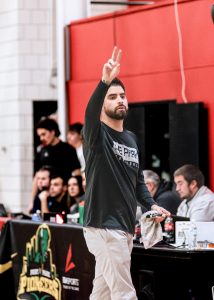COPA adjusts to online classes
April 16, 2020
Once moving through big, bright and open studios with a live accompanist and the energy of their friends alongside them, dancers now attempt to move their bodies without hitting their dresser all alone in their bedroom. An art form normally done with people for people is now being practiced in isolation.
“Being artists you crave that inspiration from your teachers and your peers, and at Point Park, we were inspired by everything around us,” senior dancer, Reba Bartram, said as she reacted and described what the transition to online learning has been like for her as a COPA student.
Life as a dancer at Point Park prior to COVID-19 included full days worth of dancing followed by late-night rehearsals. All of which took place in the bright and spacious studios in the George Rowland White Dance Center.
Now the days are looking quite different. Bartram and junior dancer Olivia Mann described how they and other dancers are struggling to try to juggle the online academics, dance papers, Zoom meetings and staying in the best shape possible.
Some of the dance professors have been holding live dance classes via Zoom, which has been very beneficial for the dancers, despite the limited space they have at home. Other professors have required video submissions of the dancers dancing or completing workouts they are doing to stay in shape, while some other teachers are only expecting them to watch videos or movies about dance and complete discussion boards and essays on them. With all of these new learning methods, many of the dancers are still left feeling unfulfilled.
“Our dance program is so close-knit, and we are all always there in the studios together,” Bartram said. “When I wanted to talk to a teacher or get any kind of feedback, there was so much opportunity for that, which is something that you will not find present today in our virtual learning atmosphere.”
The dance majors feel very lucky to get such personal feedback from their professors on a daily basis. Dancing with these professors every single day for four years inevitably gives them a bond with one another. Bartram and Mann both shared that they feel some teachers are trying really hard, while others have barely reached out at all.
“We are all in the same situation right now, but it is still different for everyone,” Bartram said. “Not only could students be dealing with family issues, money issues, family business problems or just their own mental health, but everyone learns differently. I wish all the dance professors would reach out asking how we are all doing and give us that opportunity to lean on them for support and guidance.”
However, students are not the only ones dealing with this major shift in education. The dance professors quickly had to move a dance course online, while still making it as beneficial, productive and enjoyable as possible. Jazz professor Michelle Van Doren opened up about her experience making this transition.
“It was a definite challenge, but I embraced this transition as an opportunity to expand my breadth of knowledge and skills,” Van Doren said. “The hardest part was coming up with creative ways to teach a dance studio course in an online format. I am pretty sure I worked triple-time for a week to get my course to a point where I felt happy with it, but ultimately I was proud of the outcome.”
Mann described the dance program to be a positive and comfortable atmosphere between her professors and her peers:
“Being side by side with my peers, day in and day out, they were what inspired me and motivated me to get up and try my absolute best no matter what,” she said.
Now, being left with only themselves as their teacher and motivator, the dancers have expressed how big of a struggle that can be, especially at home during a time like this.
“As a dancer, it’s very difficult to stay in the shape we were in when we were at school,” Bartram said. “Of course, we can go on a walk or do workout videos but any dance class we try to do now has most of us holding onto a wall, on a carpeted floor, with no space. My strength and flexibility feel totally hindered due to the restrictions I have. It just leaves me wondering how much my technique will suffer from all this.”
Mann said she has experienced the same thing while trying to get herself back into her routine as a ballet dancer. “The flooring we were used to, versus what we are working with now doesn’t compare at all, it’s not safe especially for those of us trying to do pointe.”
Dance, especially pointe work or anything in heels, cannot be done fully without the proper flooring and space. When asked if this big adjustment in their dancing has changed their mental health, both Mann and Bartram admitted that it had.
“It has affected my mental health in that I want to be in a dance studio, especially as someone who is graduating,” Bartram said. “It is difficult to accept not being able to train right before going into the real world. At the same time, it is strengthening me and my mental health in so many other ways I didn’t know was possible.”
“It feels like the growth and development of my dance technique has come to a halt, and it is all on me now to continue feeding it,” Mann said.
Yet, she has been trying to maintain a positive attitude as best as she can.
“At first, I was very sad about everything; the world, all we had to look forward to and being away from friends,” Mann said. “I keep reminding myself that I am doing what I have to do, I am doing my part and that’s all I need to focus on.”
Van Doren also addressed this issue with an encouraging and inspiring mindset.
“It will impact each of us differently, but I believe those who will suffer the most loss in the end — be it in technique, artistry, mental health — are not those with the most challenging personal circumstances, but those with the challenging mindsets,” Van Doren said. “The wrong attitude could destroy you in times like this. These are the moments where we develop resilience, strength of heart and depth of character to face the many challenges life will throw our way. We must embrace the struggles with an attitude of acceptance, positivity and compassion toward ourselves and those around us who are struggling too.”
Although things have come to a dramatic change, there are silver linings everywhere. Van Doren has noticed students embracing the challenges and growing in ways they never would have in the studio, people everywhere uniting in support of one another and students dealing with extraordinary hardships are stepping up courageously to make the most of every opportunity that brings them closer to fulfilling their dreams.
“I get to watch awesome videos each week of my beautiful students dancing in their homes, with their pets, on the beach, pushing their creativity to new limits,” Van Doren said. “They are bright rays of sunshine in the grey skies of our pandemic world.”



















